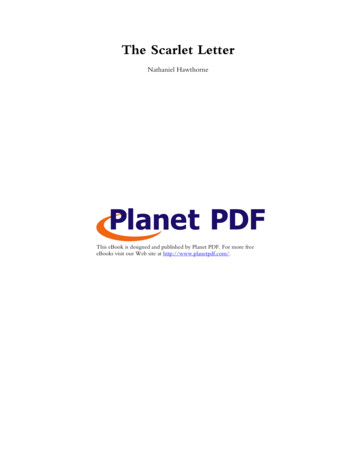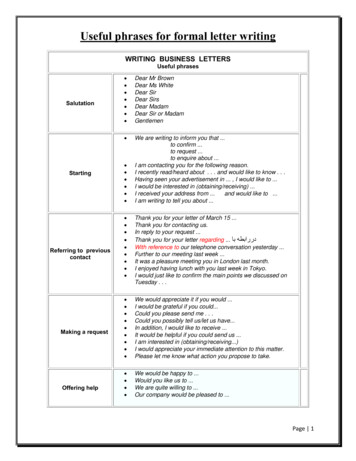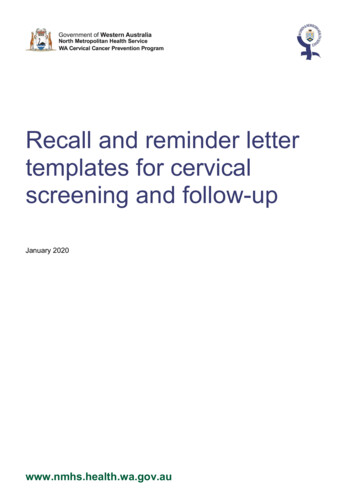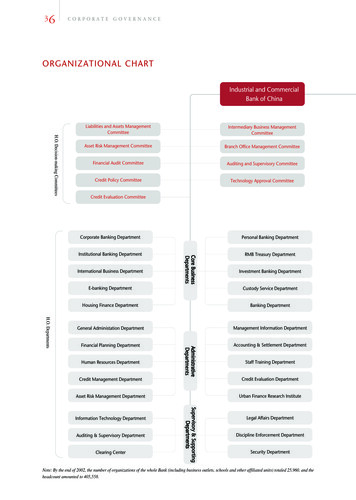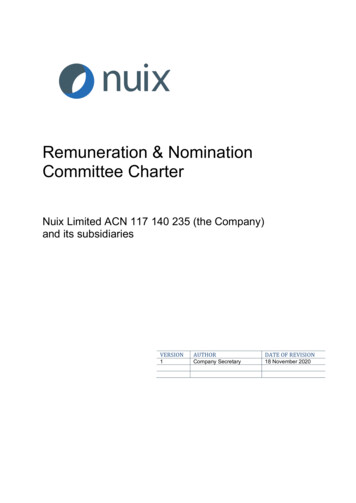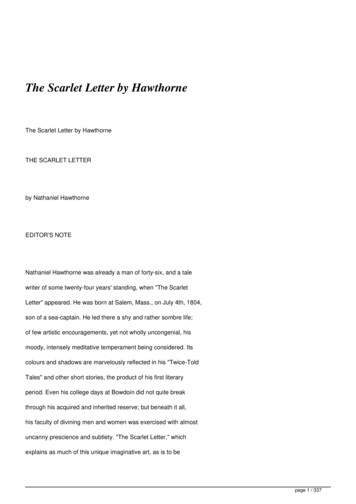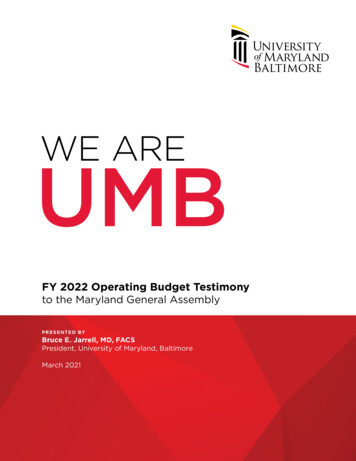
Transcription
LETTER TO THE COMMITTEEThe University of Maryland, Baltimore is committed toimproving the human condition through leadership ineducation, research, clinical care, and public service.We train the professionals who secure the health and wellbeing of Maryland’s citizens and who promote the rule of law.We create the knowledge that cures disease and strengthenscommunities, locally and globally. We develop the practitionersand innovators who drive discovery and fuel economic growth.I am grateful to Gov. Larry Hogan and the Maryland GeneralAssembly for their continued support of UMB as we striveto keep Maryland strong. In the pages that follow, you’ll seesome of the ways in which UMB is expanding efforts to trainMaryland’s workforce, invigorate its economy, and provideexceptional care and counsel to citizens across the state.We remain eager to work with you in building Maryland’sfuture — one shaped by knowledge, innovation, and, always,deep compassion.Sincerely,Jay A. Perman, MDPresidentUN IVER SITY OF MA R YLA N D, B A L T I MORE1
WE ARE UMBThe University of Maryland, Baltimore (UMB) is Maryland’s public health, law, and human servicesuniversity. We are a leading U.S. institution for graduate and professional education and a thrivingacademic health center combining cutting-edge biomedical research and exceptional clinical care.UMB enrolls more than 6,700 students in six nationally ranked professional schools and aninterdisciplinary graduate school. We offer 43 doctoral, master’s, and bachelor’s degree programs and 19certificate programs.UMB is among the country’s pre-eminent public research universities, last year attracting 556 millionin grants and contracts — the third-highest total ever recorded by UMB and by any University System ofMaryland institution. We are aggressive in commercializing our science, pushing dozens of inventions tothe marketplace each year, and launching startups that bring revolutionary ideas to life.Our growing BioPark is Baltimore’s biggest biotech cluster, with dozens of companies and researchinstitutes employing 1,000 people and actively building the city’s science community. Our BioPark fuelsthe commercialization of new drugs, diagnostics, and devices, and catalyzes economic and communitydevelopment in one of Baltimore’s poorest neighborhoods.UMB occupies 70 buildings over 71 acres in downtown Baltimore, but our academic and clinical footprintextends well beyond the city. We’re operating dental clinics for underserved patients in Frederick,Carroll, and Cecil counties. We’re expanding primary care access for vulnerable populations in PrinceGeorge’s County. With University System partners across the state, we’re planning to build a regionalphysician assistant training network, so that these providers can serve their local communities. Last year,we admitted our first class of students to the Family Nurse Practitioner program at the Universities atShady Grove. We care for hundreds of thousands of Marylanders through health and human servicesdelivery sites across the state.As one of Baltimore’s most powerful anchor institutions, UMB is deeply committed to using its influenceand assets to bring greater equity and opportunity to city residents deprived of both — to improvecommunity health, strengthen schools, train the local workforce, and drive neighborhood development.The people of UMB dedicate themselves every day to the University’s abiding mission: Improve thehuman condition and serve the public good.UMB occupies 71 acres on Baltimore’s Westside.2UN IV E R SIT Y O F M ARYLAND , BALTIM O RE
UMB: BY THE NUMBERS7SCHOOLSMEDICINE LAW DENTISTRY PHARMACY NURSING GRADUATE SOCIAL WORK77%IN-STATESTUDENTS7,360 FACULTY AND STAFF6,703 STUDENTSUMB ENROLLMENT BYRACE/ETHNICITY43%MINORITYSTUDENTSAmerican Indian 0.1%Asian 16.1%Black 17.7%Hispanic 6%52%SHARE OF MARYLAND’SPROFESSIONAL PRACTICEDOCTORAL DEGREESCONFERRED BY UMBMultiple Races 3.3%Non-Resident Alien 4.2%Unknown 1.8%White 50.7%Minority students are those who identify as American Indian, Asian,Black, Hispanic, Pacific Islander, or Multiple Races.In fall 2017, UMB had no enrolled Pacific Islander students.62 DEGREE AND CERTIFICATE PROGRAMSProfessional practice doctoral degrees data: Spring 2016All other data: Fall 2017UN IVER SITY OF MA R YLA N D, B AL T I MORE3
UMB: BY THE DOLLARS 18,110 JOBS CREATED 1.1 BILLION TOTAL UMB REVENUE 2.8 BILLION 556.1 MILLIONTOTAL IMPACT ONMARYLAND’S ECONOMYGRANT AND CONTRACTAWARDS 139.3 MILLION STATE AND 1.1 MILLION GRANT AND CONTRACTLOCAL GOVERNMENT REVENUESAWARDS PER CORE FACULTY MEMBER 13 UMB’S RETURN ON INVESTMENT 68.1% SHARE OF REVENUE GENERATED BYAll data: FY 2016All data: FY 2017FOR EVERY 1 OF STATE SUPPORTENTREPRENEURIAL ACTIVITIESUMB REVENUE, FY 201727.8%PATIENTCARE37%GRANTS ANDCONTRACTS11.8%TUITIONAND FEES3.3%AUXILIARY SERVICESAND OTHER20.1%STATE APPROPRIATIONSUMB FUNDING TRENDS, IN MILLIONSSTATE APPROPRIATIONSTUITION & FEESFY 2019 233.4 147.5 802.1ENTREPRENEURIAL REVENUESFY 19 data is based on the FY 2019 GeneralFund Operating Budget, submitted Jan. 17,2018, by Gov. Hogan.“Entrepreneurial revenues” includes hospitalcontract, grants and contracts, physician anddental service plans, and auxiliary services.“State appropriations” includes state generalfunds and the Maryland Higher EducationInvestment Fund.4UN IV E R SIT Y O F M ARYLAND , BALTIM O REFY 2014FY 2009 196.6 181 0 116.7 705.3 92.9 634.9 200 400 600 800 1000 1200
UMB EDUCATES MARYLAND’S PROFESSIONAL WORKFORCEIn-state students comprise 77 percent of UMB’s overall enrollment. Many of our graduates are thestate’s front-line practitioners, tackling Maryland’s greatest challenges in health, law, and human services.PROFESSIONAL PRACTICEDOCTORAL DEGREE:82.2% IN-STATE17.8% OUT-OF-STATETOTAL ENROLLMENT: 3,081BACHELOR’S DEGREE:94.7% IN-STATE5.3% OUT-OF-STATETOTAL ENROLLMENT: 929MASTER’S DEGREE:73.3% IN-STATE26.7% OUT-OF-STATETOTAL ENROLLMENT: 2,127ENROLLMENT BY RESIDENCYDEGREE PROGRAMIN-STATE icine—MD87.0%637Nursing sical Therapy—DPT85.9%185Nursing—BSN94.4%850TOTAL ENROLLMENTIn the last two years alone, enrollment at UMB has climbed6 percent. Last year’s growth is largely attributable toincreases in the nursing practice (DNP), pharmacy (MS),nursing (BSN), and law (MS) programs.UN IVER SITY OF MA R YLA N D, B A L T I MORE5
ENROLLMENT TRENDS BY SCHOOLS AND DEGREESHISTORICAL ENROLLMENT BY harmacy616752876Social AL5,8846,3686,703HISTORICAL ENROLLMENT BY DEGREE AND er’s1,8382,0752,127Doctorate (PhD)476480448Professional Practice DoctorateResearch & Law—JD837911634Medicine—MD621663637Nursing sical L5,8846,3686,703In 2017–18, 509 UMB students are enrolled in fully onlineprograms offered by the Graduate School and the schools oflaw, nursing, and pharmacy. Over the past five years, the share ofUMB students enrolled in fully online programs has grown fromless than 1 percent to nearly 8 percent.6U N IV E R SIT Y O F M ARYLAND , BALTIM O RE
ENSURING TUITION AFFORDABILITYThe topic of college affordability hasbecome increasingly prominent inrecent years — with good reason. Forundergraduate students, the cost ofcollege attendance jumped 63 percentbetween 2006 and 2016, while consumerprices overall increased 21 percent. At thesame time, median household incomenationwide climbed by less than 3 percent.This affordability problem flows fromthe undergraduate to the graduate andprofessional school environment, whereeducation costs are typically far greater.This certainly has an impact on Maryland’sworkforce and is felt acutely in thosefields — for example, allied health — whereour demand for professionals outstripsour supply.Of course, UMB plays a key role in meeting Maryland’s workforce demand in health, law, and social work.To continue to do so, we must achieve a level of affordability that allows students from every Marylandregion and every income level to take advantage of a UMB education — which means we must definewhat “affordability” means and provide a mechanism to meet it.UMB has therefore engaged HelioCampus, a higher education analytics company, to develop: a data model that allows rapid, deep, and ongoing analysis of student debt and repayment; a set of data visualization tools to estimate affordability under various scenarios after graduation,including job location, salary, professional field, and repayment amounts; an overview of gaps in the data and how they might be closed; and a road map for future studies to understand affordability.Preliminary findings show that, in general, UMB’s professional programs continue to be affordable.Student debt at graduation has increased in recent years at a slower rate than the cost of attendance.Repayment rates (dollars per year) vary widely by program, but repayment ratios (proportion of debtpaid per year) are consistent, typically in the high single digits.Affordability based on expected wages vs. accumulated debt was fairly idiosyncratic. The interplayof accumulated debt, wages at entry into the workforce, and repayment rate makes it unrealistic togeneralize. However, we do know we have one significant challenge: For many graduates, relocating tothe lower Eastern Shore or to Western Maryland would be much less affordable than practicing in thehigh-cost/high-earning areas of Central Maryland.We already know that this reality produces an unequal distribution of health, law, and human servicesprofessionals across Maryland. As a state, we must focus on these geographic gaps in access to highquality care and counsel, and develop effective policies and incentives that lure UMB’s graduates toMaryland’s rural and underserved communities.UN IVER SITY OF MA R YLA N D, B AL T I MORE7
COSTS AND DEBT BY DEGREETOTAL COST OF ATTENDANCESCHOOL/DEGREE PROGRAMTOTAL COST OF ATTENDANCEIn-State Students2016-17 Academic YearMedicine—MDDentistry—DDSLaw—JDSocial NLNursing—DNPNursing—BSNPhysical Therapy—DPT 67,768 81,127 58,191 42,573 56,222 42,655 51,323 48,557 38,506 60,922Total cost of attendance includestuition and fees, living expenses,student loan fees, Universityhealth insurance, transportation,board exam fees, computerfees, malpractice insurance fees,instruments, books, and supplies.AVERAGE STUDENT LOAN DEBTSCHOOL/DEGREE PROGRAMMedicine—MDDentistry—DDSLaw—JDSocial NLNursing—DNPNursing—BSNPhysical Therapy—DPTAVERAGE STUDENT LOAN DEBTAll Graduating Students: Spring 2017 167,965 227,390 116,837 56,332 136,617 66,021 90,082 64,110 18,908 97,384“Debt” is that acquiredthrough federal and privateeducation loans whileattending UMB; figuresdo not include any debtcarried over from students’undergraduate education.MONTHLY REPAYMENT8GRADUATE AND PROFESSIONALPROGRAMSMONTHLY REPAYMENTNursing and Social WorkPhysical Therapy and LawPharmacy, Medicine, and Dentistry 648– 1,037 1,121– 1,345 1,572– 2,617UN IV E R SIT Y O F M ARYLAND , BALTIM O REMonthly payment is calculated at 7.00% interest,with debt to be repaid over 10 years.The nursing and social work repayment range doesnot include students earning a Bachelor of Sciencein Nursing (BSN) degree. The monthly repaymentfor BSN graduates averages 218.
CAREY LAW MOVES FORWARDAfter several years of national declines in applicants to law school, application volumes at theUniversity of Maryland Carey School of Law have stabilized and begun to increase.Although many schools, including Carey Law, have shrunk the size of their entering classes,competition for the best students remains intense, and all law schools are providing significantscholarships to the best qualified students. Carey Law has doubled the dollars devoted to scholarshipsin recent years and has enrolled its targeted number of students. However, with competitors offeringsignificantly more scholarship dollars than Carey Law, it’s essential that we continue to increase ourscholarship support to cement the progress we’ve made.Carey Law’s specialty programs — particularly those in health law, environmental law, and disputeresolution — are known for their excellence. Our clinical law program is nationally ranked and preparesgraduates to hit the ground running. Our advocacy programs train students in the skills they need to beeffective lawyers. And our newest programs in cybersecurity and crisis management are unique in legaleducation.The undergraduate MLAW programs — taught by Carey Law faculty to students at the University ofMaryland, College Park (UMCP) — have the potential to interest a new generation of students in legalcareers and to bring more UMCP students to Carey Law.JD APPLICATIONS, ENROLLMENT, AND TUITION: CAREY SCHOOL OF LAWAPPLICATIONS ENROLLMENT TUITIONFY 2016 1,733 651 16.3MFY 2017 1,879 623 15.1MFY 2018 2,100 634 14.9MApplications, enrollment, and tuition apply only to students pursuing a JD degree.“Tuition” is tuition less scholarship dollars.JD applications for FY 2018 are projected.UN IVER SITY OF MA R YLA N D, B AL T I MORE9
UMB TAKES CARE OF CITIZENS STATEWIDEUMB is Baltimore-based and deeply dedicated to our city, but the University is actually at work acrossMaryland every day, providing professional education and clinical care and counsel that save and enrichlives — from the Eastern Shore to Western Maryland and everywhere in between.Serving Vulnerable Patients: Prince George’s CountyThe University of Maryland’s Interprofessional Care Transitions Clinic (ICTC) is designed to expandaccess and continuity of care for Medicare, Medicaid, and newly insured patients discharged from theUniversity of Maryland Prince George’s Hospital Center who lack access to primary care providers. Thegoal is to decrease hospital readmissions and emergency department visits by providing uninterruptedservices to complex patients as they undergo transitions in care.The ICTC, a collaborative effort of UMB’s schools of pharmacy and nursing, helps patients connect toproviders within the community by combining the work of the clinic (based at the University of MarylandFamily Health and Wellness Center in Cheverly), the Governor’s Wellmobile, and UMB’s e-Health Center.All three programs work together to provide vulnerable patients access to pharmacy, nursing, law, andsocial services. This integrated, team-based approach has proved effective in keeping patients out of thehospital and in their home communities.Opened in summer 2017, the ICTC is supported with funds from UMB’s schools of pharmacy, nursing,social work, and law; from the Prince George’s Hospital Center; from the Governor’s Wellmobile; andwith 1.2 million (over two years) from the Maryland Community Health Resources Commission.Growing Maryland’s Primary Care Workforce: StatewideBy the early 2020s, it’s predicted the U.S. will need as many advanced practice professionals in theworkforce — e.g., nurse practitioners, physician assistants (PAs) — as we need physicians. Especially inrural areas, where these professionals are the most likely providers of health care, there are insufficienttraining programs to meet community demand.Since 2015, UMB has partnered with Anne Arundel Community College (AACC) to strengthen Maryland’sprimary care PA workforce. Students completing the two-year, post-baccalaureate AACC/UMB PhysicianAssistant Program receive a credential from AACC and a Master of Health Science from UMB.The AACC/UMB program is competitive, with 900 applicants each year vying for only 40 seats. Onaverage, 80 percent of the program’s students are Marylanders, and they remain in Maryland to practice;more than 30 percent of graduates choose to practice in primary care.In 2016, the program took on 40 additional students from the Eastern Shore, where primary careproviders are desperately needed. The last of these students will complete their training at the end ofthe 2017–18 academic year.Given the positive results of this collaboration, UMB has requested enhancement funding in FY 2019to develop a regional PA training network serving the Eastern Shore, Western Maryland, and CentralMaryland. By partnering with local programs in these areas — including those in planning with theUniversity of Maryland Eastern Shore, Frostburg State University, and Towson University and theCommunity College of Baltimore County — we’ll increase the state’s PA workforce and retain theseprofessionals in high-need regions, for we know that students trained in their home communities aremore likely to practice in these communities once their training ends.10U N IV E R SIT Y O F M ARYLAND , BALTIM O RE
Providing High-Quality Oral Health Care: Cecil and Harford CountiesWest Cecil Health Center (WCHC) provides health care services to residents of Cecil and Harford counties,regardless of a patient’s insurance status or ability to pay. In 2014, with a rising need for dental providerspresenting a large gap in dental services for the counties’ residents, WCHC expanded its primary care,women’s health, and behavioral health services to include a four-chair dental suite staffed by one full-timegeneral dentist and one part-time hygienist. The result was an immediate and overwhelming demand, andwithin one year, that demand exceeded capacity, creating wait times of six months or more for new patientappointments.The only other organization in Cecil County offering similar services was a Perryville clinic operated byUMB’s School of Dentistry. This clinic opened in 2008 as a 26-chair dental center providing comprehensivecare for children and the elderly as well as emergency services for adults. The center offered clinicalexperiences for dental students (supervised by the school’s faculty) and served as a model for otherUniversity/community collaborations. Indeed, the School of Dentistry has established similar partnershipswith clinics in Frederick and Carroll counties, providing vital oral health services to low-income anduninsured residents.In 2017, West Cecil Health Center and UMB’s School of Dentistry formed a collaboration aimed atincreasing access to affordable dental services. This partnership — with funding from the MarylandCommunity Health Resources Commission and Union Hospital — helps fill the gap in oral health careaccess by providing the community a 26-chair dental center offering comprehensive, acute, andemergency services. These services, provided on a sliding-fee scale, are delivered to all patients, regardlessof their age, insurance, or ability to pay.Protecting Undocumented Residents: StatewideWith the U.S. Department of Justice cracking down on illegal immigration and a commensurate rise inthe detention and deportation of undocumented residents, the Carey School of Law has expanded itsImmigration Clinic, making it possible to help a larger number of people in urgent need of advice andassistance. The clinic serves undocumented residents statewide.Under the supervision of licensed attorneys, students in the Immigration Clinic represent individuals fleeingpersecution in their homelands and seeking asylum in the U.S.; those in danger of being deported becauseof criminal convictions; and those who have been victims of domestic violence or other crimes. Studentsalso assist in bimonthly pro bono consultations with people in removal proceedings, advising publicdefenders on the immigration-related consequences for their clients.The clinic has handled a number of cases challenging abusive enforcement practices by the government,and the clinic’s students may advocate before the Department of Homeland Security, the Board ofImmigration Appeals, the Baltimore Immigration Court, and the federal courts.UN IVER SITY OF MA R YLA N D, B AL T I MORE11
Educating Maryland’s Nursing Workforce: Capital RegionUMB’s School of Nursing is Maryland’s largest public nursing program and a leader in educatingMaryland’s nursing workforce. Nurses make up the single largest segment of the U.S. health careworkforce, and Maryland’s demand for more (and more highly trained) nurses is acute: The state is oneof 16 in the nation — and the only one in this region — projected to have a nursing shortage by 2025.The School of Nursing has 310 nursing students enrolled at the Universities at Shady Grove (USG) inMontgomery County; enrollment in the Bachelor of Science in Nursing (BSN) program at USG comprises39 percent of the school’s overall BSN enrollment. The USG location, convenient for nursing studentsfrom Maryland’s Capital Region, also hosts 26 percent of the school’s total RN-to-BSN enrollment.This pathway is critical for practicing nurses who want to earn their bachelor’s degree — a degreeincreasingly required for employment and advancement. National survey data indicate that 86 percentof hospital and health care employers prefer BSN-prepared nurses, and 49 percent require BSNs for allnew hires.In fall 2017, the School of Nursing began offering a Doctor of Nursing Practice (DNP) Family NursePractitioner specialty at USG. The overall growth of the school’s DNP program — up from just 81 studentsin 2012 to 473 in 2017 — and its expansion to the USG location fulfill state and national recommendationsto increase the number of nurses educated at the doctoral level, which is considered essential to reliablyproviding high-quality, patient-centered care across services and sites.Dual Admission Serves Nursing Students StatewideUMB’s School of Nursing has a dozen dual-admission agreements — either in force or in development — with communitycolleges across Maryland. These agreements allow students to complete two years of coursework at a communitycollege, earn their Associate Degree in Nursing, and then transition seamlessly into the School of Nursing’s BSNprogram — either at the UMB campus in Baltimore or at the USG location in Montgomery County.Dual admission streamlines the path to a BSN. Plus, students’ access to upper-level courses in the early years of theirnursing education increases their likelihood of success in the bachelor’s program.More than 100 Maryland students have earned, or are pursuing, their BSN through dual admission, and that number willgrow dramatically as new dual-admission programs mature and as programs in development come online.Expanding Access to Social Workers: Baltimore CityIn fall 2017, UMB’s School of Social Work began partnering with the Enoch Pratt Free Library to meetsocial work clients where they are and increase their access to government services that can alleviatesuch challenges as poverty, food insecurity, homelessness, and addiction. Libraries, long embedded inBaltimore’s neighborhoods, contain stable and natural support systems for their customers, and serve asa safe place to find answers to questions and to secure resources.The Social Worker in the Library program places two graduate social work interns in each of four EnochPratt branches around the city. The interns work in the library two days a week for eight-month rotationsand are supervised by social work faculty. The students provide one-on-one counseling for libraryclients and train library staff in such areas as crisis management and positive engagement. The studentsalso conduct significant outreach within the library and in the surrounding community to construct alandscape of needs and — with library staff — identify community members who might take advantageof services.Funding for the program has been provided by the Institute of Museum and Library Services, the PNCFoundation, the Greif Family Foundation, and other philanthropic organizations.12U N IV E R SIT Y O F M ARYLAND , BALTIM O RE
RESEARCH DOLLARS CLIMB AT UMBIn FY 2017, UMB experienced very strong growth in federal, foundation, and corporate researchfunding, which offset a modest decrease in state-sponsored grants and contracts (G&C). In fact, UMB’sextramural funding totaled 556.1 million in FY 2017, up nearly 12 percent over FY 2016. This is the thirdhighest G&C total ever recorded by UMB and the third-highest ever recorded by any University Systeminstitution.In FY 2018, we’re continuing to see strong growth in federal research funding — from the NationalInstitutes of Health (UMB’s largest source of research dollars) and from other federal agencies. As ofJanuary 2018, year-over-year research revenues are up 16 percent compared with 2017. This growth isdue partially to the imminent opening of Health Sciences Facility III, UMB’s newest research building.Some of the renowned research faculty who have been recruited to locate in the building have alreadystarted working at UMB, bringing with them significant research grants.UMB RESEARCH AWARDS, IN MILLIONS 600 500 400 300 200 100 0FY ’08FY ’09FY ’10FY ’11FY ’12FY ’13FY ’14FY ’15 FY ’16FY ’17FY ’18FY 2018 awardsare estimated.Pioneering TransplantationIn summer 2017, UMB’s School of Medicine established the nation’s first Center for Cardia Xenotransplantation Researchwith a 24 million grant from the Maryland-based biotech company United Therapeutics.Xenotransplantation involves the transplantation of organs from one species to another. With human organ transplantwait times extending to months — and sometimes years — xenotransplantation researchers are exploring the means togenetically modify and transplant animal organs into humans to eliminate this shortage.The Transplant Division of the School of Medicine’s Department of Surgery has had a longstanding xenotransplantationresearch program and is considered one of the nation’s leading centers for such investigations. The new cardiacxenotransplantation initiative will help UMB expand and accelerate this effort.UN IVER SITY OF MA R YLA N D, B A L T I MORE13
ADVANCING CLINICAL TRANSLATIONAL RESEARCHMore than a decade ago, the National Institutes of Health developed a grant program to improve andaccelerate the translation of laboratory science into the drugs, devices, and treatments that extend andenrich people’s lives. This Clinical Translational Science Award (CTSA) Program helps universities tacklesystemwide problems that choke progress in scientific translation; innovate processes that improve thequality and efficiency of translational research; engage patients and communities in every phase of theresearch; and train the next generation of translational scientists.Across the country, 64 medical research institutions have won CTSA grants, Johns Hopkins Universityamong them. Last fall, UMB joined in Hopkins’s CTSA renewal application. With UMB and Hopkinspartnering in this CTSA effort, we can aggregate patient data from both hospital systems to ask researchquestions in a powerful way. We can link our master’s degree programs so that clinical research traineesat UMB and Hopkins gain broader and deeper expertise. We can combine aspects of our clinical researchinfrastructure to develop not only higher quality programs, but also programs with a more expansivereach across the state.UMB enriches this project through extensive training and degree programs that complement the CTSA,and through our diverse collection of schools — in health sciences, social work, and law — that serves toincrease the application’s competitiveness.This collaboration between Baltimore’s two most powerful research institutions is vitally important to thepeople of Maryland. Together, the University of Maryland Medical System and Johns Hopkins Medicineserve three-quarters of the state’s citizens. This alliance will help us build the infrastructure, forgethe partnerships, and secure the money that ultimately yield breakthroughs in translational process.Essentially, this is our best opportunity to get more treatments to more patients more quickly.CTSA awards will be announced in spring 2018.Dr. Susan Dorsey and Dr. Joel Greenspan, co-directors of UMB’s Center to Advance Chronic Pain Research14U N IV E R SIT Y O F M ARYLAND , BALTIM O RE
PUTTING DISCOVERY TO WORKAcademia and industry intersect at UMB. In FY 2017, UMB conducted 582 translational research projectsand clinical trials on behalf of 270 corporate sponsors. Since FY 2012, corporate-sponsored research atUMB has more than doubled to 67 million.UMB is aggressive in moving our science out of the lab and into the marketplace, where it can have ameaningful impact on human health and well-being. In FY 2017 alone, 40 UMB inventions were licensedto private companies — our highest ever one-year licensing total. Additionally, nine new startup companies — launched with UMB’s intellectual property — are raising private capital to accelerate the transitionfrom idea to innovation to impact.TECHNOLOGY TRANSFER AT UMBInvention DisclosuresStartupsLicensesFY 2012FY 2016FY 20171-Year Growth13132113610341469407%(10%)18%5-Year Growth12%200%91%Improving Health in the Developed and Developing WorldsPaxVax begins sales of UMB-invented Vaxchora, the only cholera vaccine approved by theU.S. Food and Drug Administration.Nearly 3 million people around the world contract cholera each year, and without immediate treatment,the disease can cause death within hours. Asia and sub-Saharan Africa account for most of the world’scholera burden. Natural and manmade disasters — which disrupt water and sanitation systems, crippleinfrastructure, and displace populations into overcrowded camps — can lead to catastrophic outbreaks.Vaxchora, the UMB-invented vaccine, provides protection with a single dose, making it invaluable for firstresponders and others traveling to 69 countries with endemic cholera.UMB startup Remedy Pharmaceuticals sells its stroke therapeutic to BioGen for 120 million.Each year, nearly 2 million people in th
UNIVERSITY OF MARYLAND, BALTIMORE In 2017-18, 509 UMB students are enrolled in fully online programs offered by the Graduate School and the schools of law, nursing, and pharmacy. Over the past five years, the share of UMB students enrolled in fully online programs has grown from less than 1 percent to nearly 8 percent. Bachelor's 810728 929


